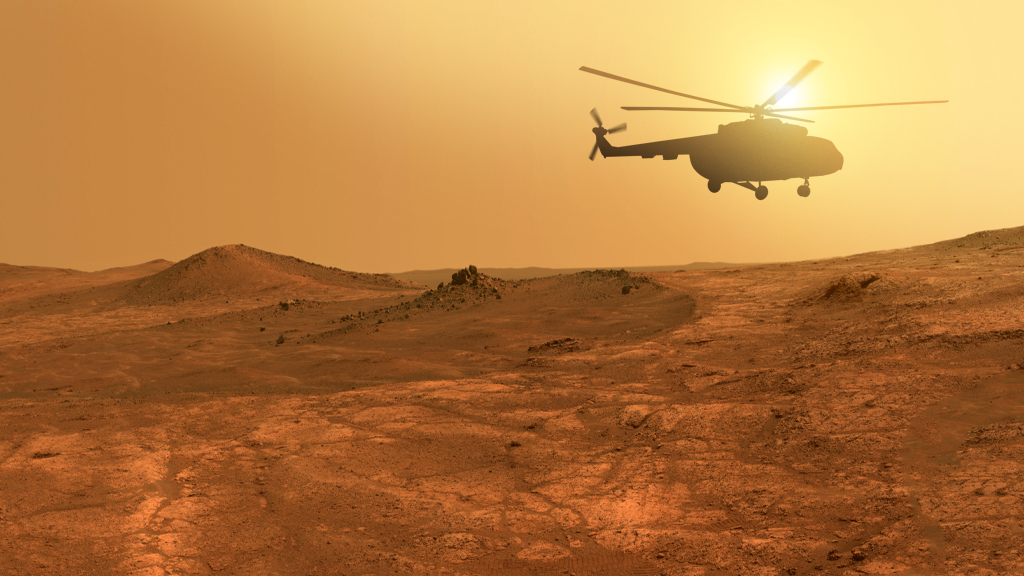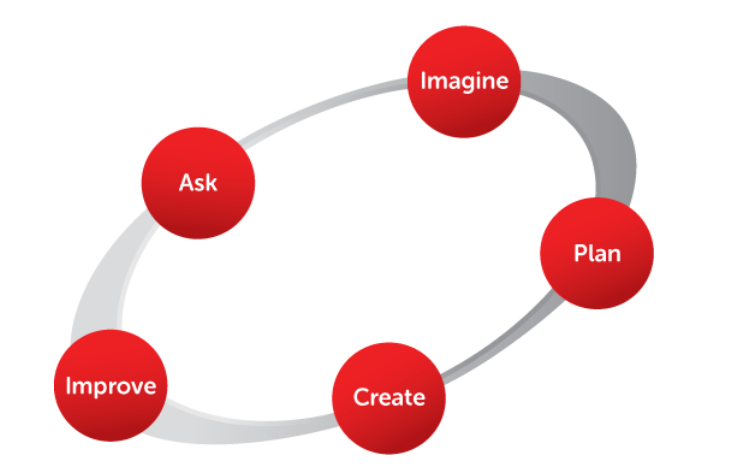Early Childhood Elementary Middle School Informal Education | Daily Do
How Can a Helicopter Fly on Mars?

Aerospace Crosscutting Concepts Disciplinary Core Ideas Engineering Is Lesson Plan NGSS Phenomena Physical Science Physics Science and Engineering Practices Three-Dimensional Learning Early Childhood Elementary Middle School Informal Education Grade 3 Grade 5 Grades 6-8 Grades 9-12
Sensemaking Checklist




Introduction
How can a helicopter fly on Mars? is inspired by the NASA Mars2020 mission which successfully launched the rover, Perseverance, this morning at 7:52 am ET. Perseverance will land on Mars sometime in February 2021. NASA will use the rover to collect data to serve as the basis for evidence that Mars once supported life in the form of microscopic organisms.
What makes Mars2020 mission even more exciting is the hope of achieving the first powered flight on another planet! The Ingenuity Mars helicopter is hitching a ride with Perseverance. NASA scientists and engineers will test their Mars helicopter design which includes maneuvering Ingenuity out of the rover, keeping Ingenuity warm (Mars nighttime temperature can reach -100 degrees F), charging Ingenuity's battery using the attached solar panel, and flying Ingenuity - each flight lasting 90 seconds. (You read that correctly - 90 seconds!)
In today's task, we take the familiar whirlybird (paper helicopter) activity and set it in the context of engineering design. Students and their families start by comparing helicopter designs, Ingenuity and "helicopter" seeds. Using questions about how blades enable helicopters to fly drive the investigation, students and their families engage in science and engineering practices and use the thinking tools of patterns and cause and effect to make sense of how air resistance helps explain how helicopters work.
Because this task is designed for families, we don't go beyond the role of air resistance in partially explaining the phenomenon. If you are working with high school students you might analyze the whirlybird system in terms of gravitational potential energy and kinetic energy. Based on the gravitational potential energy of the whirlybird, how fast (average) should the whirlybird fall? How fast does it fall? How do you account for difference in terms of energy?
View the How can a helicopter fly on Mars? NGSS table (for middle school) to see the elements of the three dimensions targeted in this lesson.
Experiencing the Phenomenon
Tell students the Mars2020 mission has you thinking about helicopters (you might share some mission information with your students). Say, "I have an intriguing phenomenon I want to share with you through two videos." Ask students to create a simple t-chart to record observations.
Ask students to label the left side of the t-chart Ingenuity Mars Helicopter. Tell students that while you play the first video, you would like them to make and record observations specifically of the Ingenuity Mars helicopter in the left side of the t-chart. Students should record questions that arise on a facing page of their science notebook, separate page, or sticky notes. Play the Mars Helicopter video.
Next, ask students to label the right column of their t-chart helicopter seeds. Play a short clip from the Seeds video, 0:10 to 1:10, and ask students to make and record observations. Students should also record questions that arise.
Say to students, "How are the Mars helicopter and the helicopter seeds similar? How are they different?" Give students independent thinking time to compare their observations of Ingenuity and the falling seeds. Then, put students into groups and ask them to create a group list of similarities and differences and to note any patterns they observe.
Bring the class back together. Ask each group to share a similarity or a pattern they think might help explain how the helicopters are able to fly. Students may share some of these similarities or patterns:
- They all have at least one blade.
- They all spin.
- The blades don't change direction once they are spinning.
- The blades are attached to something.
- The thing blades are attached to are in the "middle" or center of the spin.
- The blades are horizontal (parallel to the ground).
Ask students to review the questions they have recorded and to add at least one new question about the phenomenon (helicopters flying) they observed. Ask students to share three questions with their group. Then, ask each student to choose one question they want to investigate to help explain how helicopters fly. It's OK if group members choose similar questions.
Ask for one volunteer to share and post their question (a sticky note placed on a poster either in the classroom or through use of a digital tool). Ask that all students with similar questions to post their questions near the first post. Continue in this manner until all students have posted one question. Questions may include:
- Do more blades/less blades make the helicopter stay in the air longer?
- Does spinning faster make the helicopters stay in the air longer?
- What makes blades spin faster (is it just the motor)?
- Do you need a motor to go "up"? (Could seeds go up - higher in air - without a motor?)
- How are helicopter blades different than propellers (on planes)?
- Does the shape of the blades matter? (Do different shapes keep the helicopters in air longer?)
- How do the blades keep the helicopters in the air?
- Does the size of the blade make a difference (length, width, thickness)?
Say to students, "We have a lot of different questions about blades. Does it make sense to investigate blades first?"
Investigating Helicopter Blades
Materials
- Paper helicopter template printed on plain paper (at least two per student)
- scissors
- pencils
- rulers or measuring tape
- stopwatches
- variety of paper large enough to fit template (plain paper, wax paper, construction paper, file folder, tissue paper, etc.)
- video camera (optional)
Tell students we are all going to make a paper helicopter to more closely observe the helicopter motion. Give each student a paper helicopter template and ask them to create a paper helicopter (directions included on template). Allow students time to play with the paper helicopter. Then, ask students to make and record observations while the paper helicopter is flying. You might have them use a video camera to record the flight of the paper helicopter and then watch the flight in slow motion to make additional observations. Students might also use the video to determine how long it takes the paper helicopter to reach the ground (drop time). (It's OK if students want to calculate the drop rate/speed, but don't worry if they don't at this time.)
Next, ask students to independently consider how they would investigate how a particular feature (variable) affects how long the paper helicopter stays in the air. Ask them to also think about what data they would collect. You might ask students to record their ideas. Give students time to turn and share their ideas with a partner. Then ask students to share their ideas with the class. Students might share these ideas for investigations (follow-up questions):
- Change the length of the blades How might we do that without changing the mass of the paper helicopter? Fold the blades to create different lengths.
- Change the width of the blades How might we do that without changing the mass of the paper helicopter? Fold the blades to create different widths.
- Change the number of blades. Cut the blades into two, three, etc., and fold them into the position you want.
- Change the length of the piece the blades attach to. You can fold it to different lengths. Maybe use a tiny piece of tape to keep it folded.
- Change the shape of the blades. Fold the blades into different shapes.
- Change what paper helicopter is made out of. Why do you want to use different materials? Lighter materials might keep the paper helicopter in the air longer.
Ask students, "What data might we collect? Why?" Students might say (follow-up):
- How long it takes to drop. How might we measure that? We can time them or drop all the ones we are testing and record which order they fall in. What if we wanted to compare your data with this group's data? How would we know if your slowest paper helicopter was faster or slower than their slowest paper helicopter? We could drop all the slowest helicopters at the same time and see which one is the slowest of all. How else might we compare our results? We can drop them all from the same height. We could calculate the speed of the fall. Which method do we want to use?
- How fast it spins. Why do you want to know how fast it spins? It might tell us that paper helicopters that fall slowly spin faster than other paper helicopters. Then you would try to make the helicopter spin as fast as you could. How might you measure this? Take a video and count the spins.
- How straight it falls. Why would you want to know if it falls straight? Paper helicopters that don't fall straight down may stay in the air longer. How might you measure the straightness of the fall? Put a spot under it and measure difference from spot. Make a target on the floor and see how close to the center of the target it falls.
You may need to have a conversation with students about the number of different paper helicopters to test and the number of trials. For example, if a group is testing length of blade they might create one helicopter with the full blade length, one with blades 2 cm shorter, and one with blades 4 cm shorter. Then drop each helicopter three times.
Assign students to small groups (3 or 4 students) based on the variable they want to test. Ask them to collaboratively plan an investigation to figure out if changing that variable affects how long the paper helicopter stays in the air. Allow them time to conduct their investigation.
When groups have completed their investigation, you might have them share their results in one ore more of the following ways:
- Create a collaborative online space, such as a Google doc or Google sheet, for students to report their data. You might want to create space for students to include qualitative (written descriptions and/or drawn images) as well as quantitative data.
- Ask student groups to use Flipgrid (or similar digital tool) to share their data. One student can start the group video, and then the remaining group members can add to the share by leaving a video comment.
- Ask students to post an image of their group data table on Jamboard. Groups that tested the same variable can post on the same frame. Then students can identify patterns in data on one frame, and then patterns in data across frames.
Ask students to identify patterns in data between groups that tested the same variable and also patterns in data across all the different variables tested. Students then meet with their group members to share the patterns they've identified. You might give students the opportunity to ask other groups questions about their results. For example, students might ask a group who collected data dropping paper helicopters with different length "bases" (the thing the blades attach to), "Why do you think the drop time decreased when the base got shorter?" The group may reply, "When the base got shorter, the helicopter tipped over." (All of the methods described above allow student groups to communicate.)
You might ask student groups to share their ideas about all of the patterns have in common, or what all the slowest paper helicopters had in common. Consider engaging students in a building understanding conversation:
- What are some of your claims?
- What's your evidence? (How did you reach that conclusion?)
- What data do we have that challenges Group B’s claim?
- Does any group have evidence to support Group A’s claim?
Students will likely notice the more air the blades can catch, the longer the paper helicopter stays in the air. Evidence might include longer blades, upright helicopters, blades made of stiffer paper that cause the blades to remain parallel to the ground while it falls, the widest blades all cause the paper helicopter to stay in the air the longest (drop the slowest).
You might say, "What can we conclude?" Students might say, the more air pushing on the paper helicopter, the slower it falls. Ask students, "When you say pushing what do you mean? Where is the push? What direction is the push in?" Student will likely say the air is pushing up on the blades. Ask students if any other forces are acting on the blades. Students will likely say gravity is pulling the blades down.
Return to student questions and ask them to identify the question we have answered.
Engaging in the Engineering Design Process
You might ask, "How might we use evidence from our data, knowledge of air resistance and the engineering design process to design a paper helicopter that will drop more slowly than our class' slowest drop time?"
Ask students to design a paper helicopter that will fall more slowly than the slowest paper helicopter the class recorded. You might emphasize that engineers rely on science ideas and evidence from data to make informed design choices and their investigation is part of the Ask phase of the engineering design process.

You might tell students designing a paper helicopter that will fall more slowly than the class' slowest paper helicopter is a criteria for success. Engineers also have to work within limits, or constraints. For this engineering design challenge, constrains could include the time allotted and the materials available for use. (Students could petition to use additional materials if they support their idea with evidence from data.) You might additionally require students use no more paper than what the template provides, but allow them to remove paper (instead of folding).
Consider asking students to independently brainstorm two paper helicopter designs. As you move around the room, ask students why they are choosing x blade length, y material, etc. Encourage them to use evidence from data to support their ideas.
Place students in small groups and ask them to share their designs. Then, ask students to create a group consensus design. Make sure to ask students to draw their design on a new piece of paper (or new space if working with a digital tool) to help create group ownership of the design.
Continue through the engineering design process. Make sure to give students an opportunity to revise and test their design at least once. Reflection questions might include:
- Was your design successful (did it fall more slowly than the slowest time the class recorded)?
- What is one thing you really like about your design. Why?
- How would you improve your design if you had more time or different materials? Explain how this improvement would cause the paper helicopter to fall more slowly.
You might have student groups share their designs using one or more of the methods described in the preceding section.
Spinning Seeds Inspire Single-Bladed Helicopters
You might choose to share Spinning seeds inspire single-bladed helicopter with students to show how engineering students used observations from falling helicopter seeds (science) to design single-bladed helicopters.
Explore a Career in STEM: Aerospace Engineering
Meet Michelle Lynde and Trevor Jones, NASA aerospace engineers! As you listen to their stories, you might think about these questions:
- What inspired Michelle and Trevor to become aerospace engineers?
- How are their jobs alike? Different?
- Why do they like working in the field of aerospace engineering?



